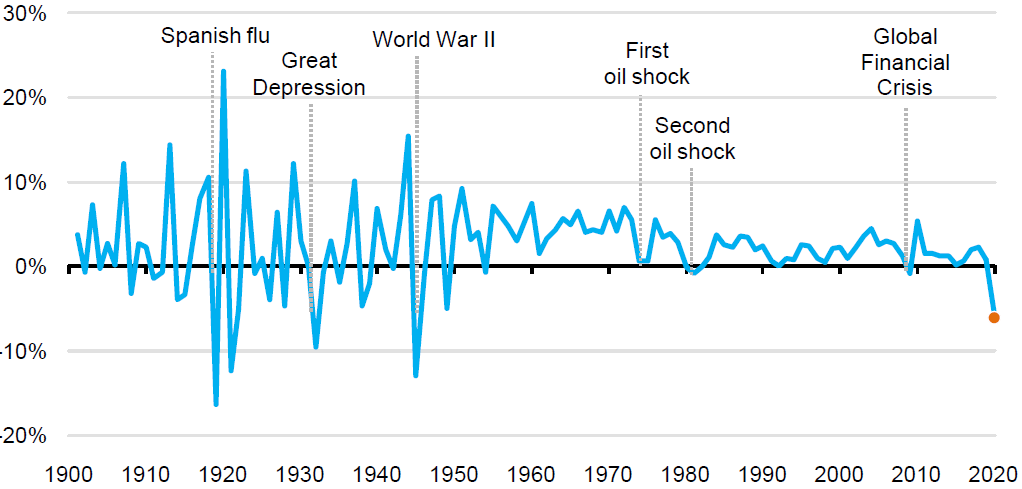
Source: IEA, Global Energy Review 2020
Under these circumstances, supply of renewable energy is expected to increase. There are three reasons for this. First, even if economic activity stagnates in many countries and the supply of energy, mainly from fossil fuels, is disrupted internationally and regionally, renewables can continue to be supplied within individual regions. Second, when energy demand is declining, it is economically rational to prioritize energy sources with low marginal costs (additional costs). Renewable energy has the lowest marginal costs because it does not require fuel. Third, government policies on climate change are being actively promoted, primarily in Europe. Even with the impact of the Covid-19 pandemic, initiatives for transitioning from fossil fuels to renewable energy are expected to be maintained or strengthened in most countries.
The economies around the world are being significantly damaged by Covid-19, but ‘green recovery’ initiatives, using climate change policy to aim for an economic recovery, are beginning in many of these countries. The EU’s European Green Deal is the key example of this. The policy was announced in December of last year, before the Covid-19 outbreak, but the plan is to promote it to achieve a green recovery while working to avert a climate crisis. The EU plans to invest over one trillion euros for the ten years from 2021 to 2030 in order to further expand clean energy and the circular economy. The plan also includes employment policies in connection with conversion of the industrial structure. The South Korean government likewise has announced its own Green New Deal with the target of decarbonization by 2050. It will phase out coal and nuclear power while expanding renewable energy, and in quickly building a sustainable society and economy through this energy transition, so that it will bolster its international competitiveness.
Japan must not allow itself to fall behind. Preventing the spread of the virus has top priority for the immediate future, but the nation needs to simultaneously devise policies to promote its energy transition. In the short term, aid to delayed renewable energy development projects and other measures are needed to keep the momentum for making renewable energy the main power source of the nation. This should include emergency measures to help projects continue moving forward, including extending application deadlines for the feed-in tariff scheme and deadlines for commencing operations. What’s most important is a medium/long-term policy that clearly steers phasing out of fossil fuels (particularly coal) and nuclear power. What is needed is a Japanese ‘Green New Deal’ that would grow new industries centering on renewable energy to every part of the country.
The Great East Japan Earthquake and Fukushima Daiichi Nuclear Disaster nine years ago clearly exposed the vulnerabilities in the power supply system in Japan, and efforts aimed at an energy transition have made steady progress, led by private companies and local governments. Although the energy supply system remains dependent on fossil fuels. Japan’s climate change policy is vastly inferior to advanced countries in Europe. The government still has not changed its unique rule that prioritizes nuclear power over renewable energy when there is a drop in power demand. Japanese regulatory code is strikingly outdated. With the calamity of Covid-19 now added to this, building a sustainable society and economy around renewable energy becomes even more important. With so many people changing how they live and work, now is the time for promoting a Japanese Green New Deal. The opportunity is there.
Changes in the energy sector due to Covid-19
Lockdown measures to prevent the spread of Covid-19 have changed power supply and demand in many countries around the world. According to the IEA report, the share of coal has declined in China and India, while renewable energy has increased (Figure 2). The share of gas in Europe and coal in the U.S has decreased. Nuclear power generally remained unchanged in these countries.
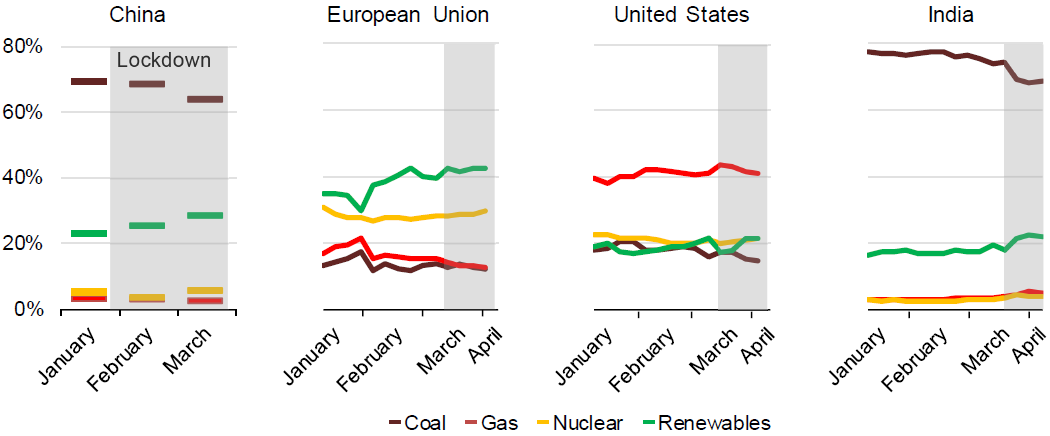
Source: IEA, Global Energy Review 2020
When power demand stagnates, output is reduced at power sources with high marginal costs. Thermal power requires fuel, so marginal costs are high; renewable energy sources like solar and wind need no fuel and the marginal costs are close to zero. As for nuclear power, the marginal costs are high when the costs of operations, nuclear fuel consumption and waste disposal are included. Lockdown has reduced power demand, so the share of coal and gas with high marginal costs, has gone down and renewable energy gone up. This is economically rational.
During a lockdown, not only electric power but fuel demand by airplanes and vehicles also decreases, as does fuel used by the manufacturing industry at factories and other facilities. According to the IEA’s projections, global energy demand in 2020 is expected to decline by 6% compared to the previous year (Figure 3). The rate of decrease will be largest for oil, coal, gas and nuclear, in that order. Only renewable energy will continue to increase, at a rate of just under 1%. Its marginal costs are low, and the workforce needed is minimal, so renewable energy is the power source least affected by lockdown measures. Assuming the continued spread of the virus remains possible, further raising the share of renewable energy becomes important from the perspective of both economic rationality and energy supply stability.
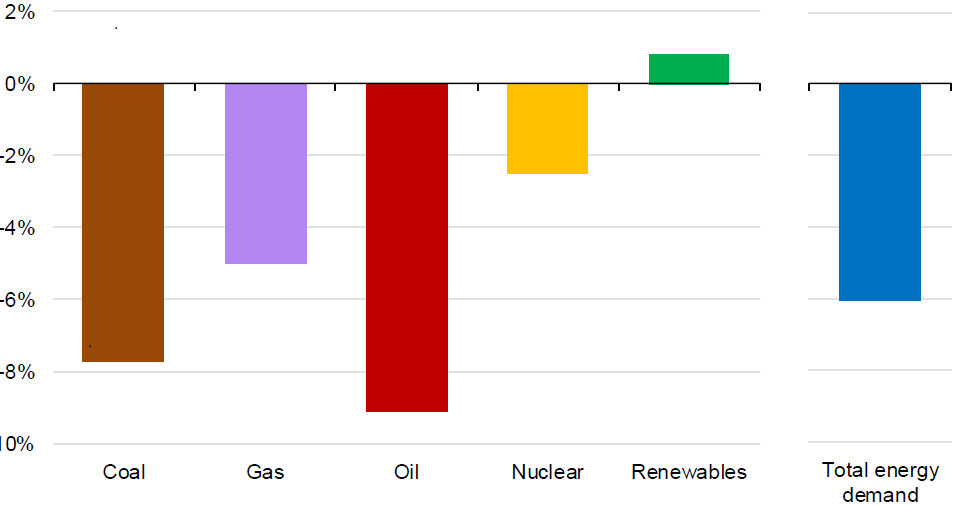
Source: IEA, Global Energy Review 2020
It can be assumed that the Japanese energy industry will be affected in the same way. In April, electric power demand compared to the previous year decreased in nine of the nation’s ten regions, with Shikoku the only exception (Figure 4). The 3 metropolitan areas, Tokyo, Chubu and Kansai saw larger declines. In the whole country demand declined by 3.6% in April from 67.2 to 64.8 terawatt-hours. However, in the major countries of Europe, demand is down by over 10%. The weather has had an impact, but the most likely reason of smaller demand decrease in Japan is that the government has not imposed a full lockdown, instead opting for voluntary restraints.
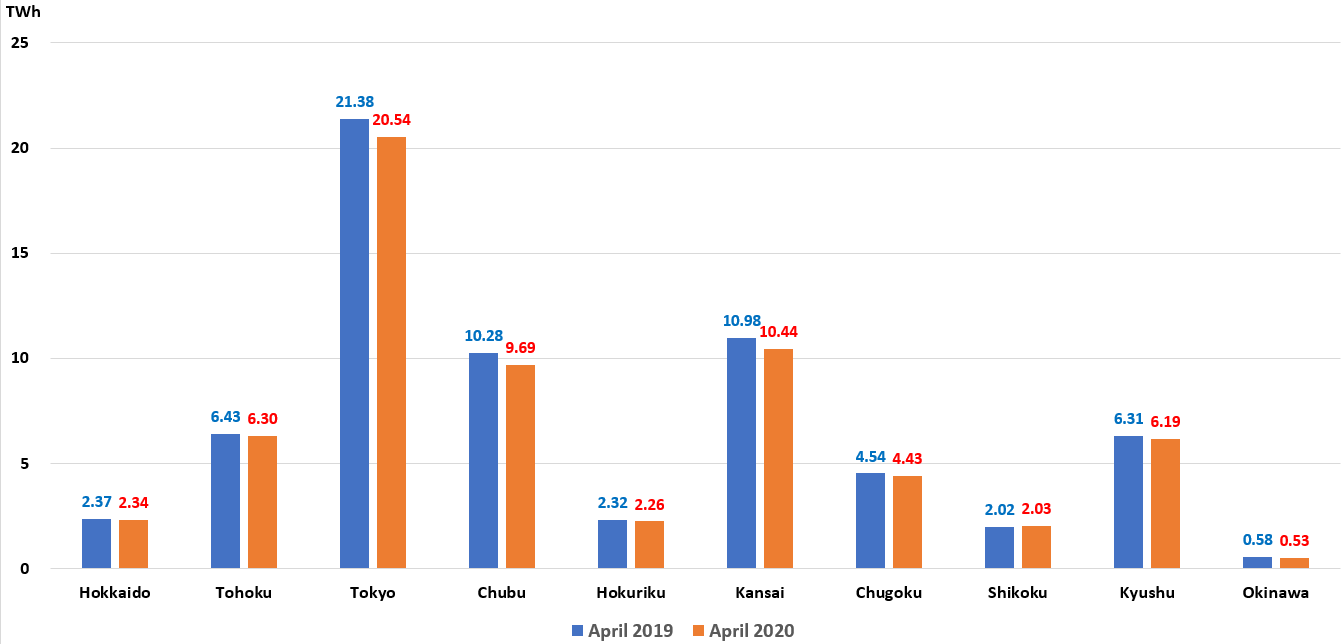
Source: Renewable Energy Institute
Even in a normal year, power demand in April is low while the supply from solar increases. This causes the spot price on wholesale power markets to decline. Looking at the spot price in the Kyushu region, there were a total of 96 hours when the price had fallen to the minimum bid of JPY 0.01/kWh (Figure 5), over five times as many hours as last year (17 hours). The average monthly price was JPY 6.80/kWh in 2019, but was 3.97/kWh in 2020, over 40% lower. This decline in the spot price is occurring in other areas as well and for the entire nation.
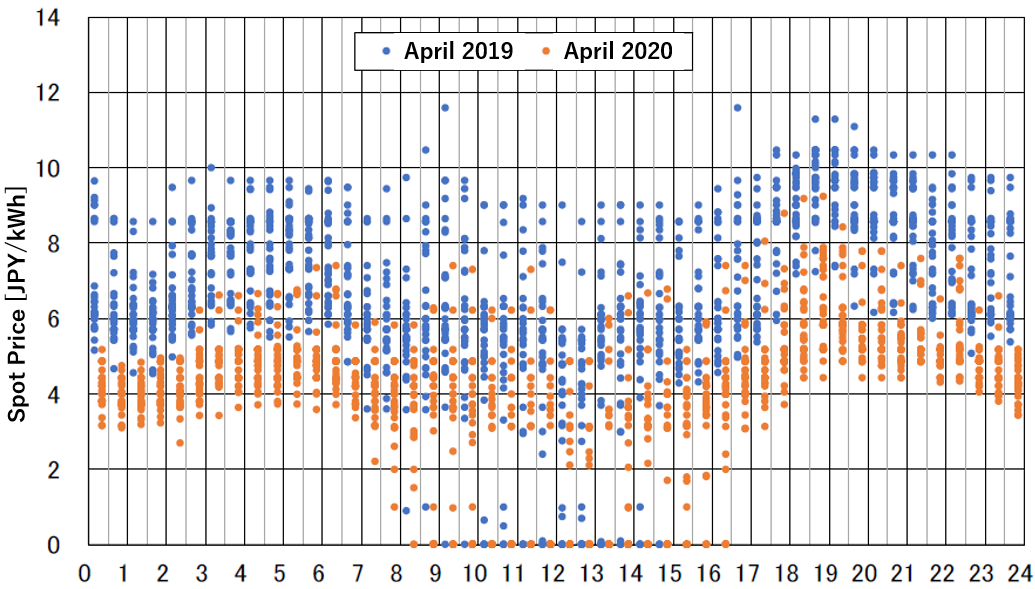
Source: Renewable Energy Institute
When demand decreases and supply increases, both the frequency and the amount of curtailment on solar and wind power increases. In Kyushu, curtailment was applied for 19 days in March, for 22 days in April and nearly every day in the first half of May. Not only the number of days increased compared to last year, curtailed power output from solar and wind combined increased nearly twofold in March (Figure 6). The curtailment rate is more than 12%. The amount of curtailment in April will be announced at the end of May and there is no doubt it will have increased by a large margin compared to March.

Source: Renewable Energy Institute
By contrast in Shikoku, a neighboring region of Kyushu, curtailment on solar and wind power has not been conducted even once. During the extended holiday period from April 25 to May 10, there were seven days when the share of solar was around 80% in daytime. On May 5, the share reached 88% from 11am to noon while the demand and supply balance has been maintained through measures such as pumped hydro power and import/export through interconnectors (Figure 7). The effect of not operating nuclear power plants has also been substantial.
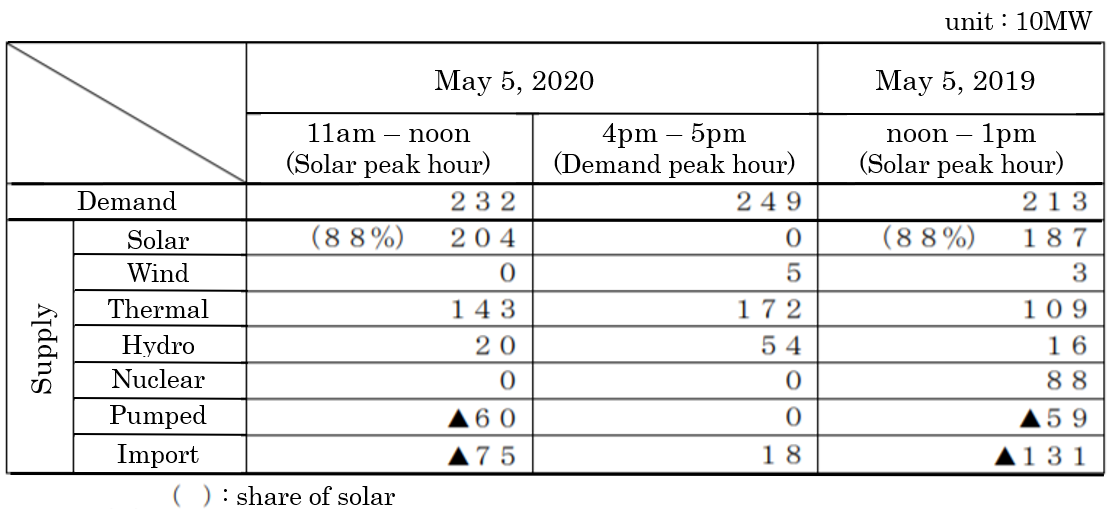
Source: Shikoku Electric Power Transmission and Distribution
Major countries overseas have adopted the merit order rule to prioritize supply of renewable energy because of low marginal costs, but Japan maintains a rule prioritizing nuclear, hydro and geothermal power by positioning them as fixed, long-term power sources. In Kyushu nuclear power plants restarted and the number of days of curtailment on solar and wind has increased. A policy of discarding renewable power while increasing spent nuclear fuel, for which no viable disposal method is in sight, has no place in a sustainable society. This policy of course is not supported by a majority of citizens. Like other countries, the government needs to change to a power supply system based on merit order as soon as possible.
Even as the global economy and energy demand head toward a recovery, investment in fossil fuels and nuclear power, which have no real future, will steadily decline. New investment will be allocated to renewable energy and will drive a green recovery. The Japanese industry needs to accurately apprehend trends overseas and develop business activities within the framework of a sustainable society and economy.
Envisioning a policy for energy transition and economic growth
As the Covid-19 virus has spread, energy supply issues have come into focus in Japan once again. There are three primary reforms need to be made. The first is transforming from internationally dependent supply system to domestic supply. Importing fossil fuels carries the risk of supply dropping off due to a large-scale disaster or epidemic. There is also the issue of price fluctuations caused by demand changes and intentions of producing countries. The second reform is changing from large-scale, centralized facilities to small-scale, distributed facilities. The Great East Japan Earthquake and Fukushima Daiichi Nuclear Disaster exposed the risks of large-scale centralized facilities. The same is the case when epidemics like Covid-19 spread into a specific region: there is the possibility of long term and wide area power outages caused by large-scale nuclear and thermal power plants going offline.
The third reform needed is shifting energy supply facilities managed and operated by large teams to facilities automated or operated by small teams. Facilities operated by many staff gathered in one place poses a high risk of spreading infection, and depending on the circumstances, it must be assumed that this could force operations to shut down. As of April 27, twelve staff at TEPCO, the largest electric power company in Japan, had been infected by Covid-19, seven in the Tokyo metropolitan area and five in Kashiwazaki City in Niigata Prefecture. They included staff working at Kashiwazaki-Kariwa Nuclear Power Plant, which is shut down since the disaster in Fukushima.
Even while the Covid-19 virus is spreading, a large number of people must continue working hard to keep the energy supply up and running. Thanks to their efforts, we are able to live our lives using electric power and fuel just as we normally do. Assuming the continuing risk of large-scale disasters and epidemics in the future, it is preferable for energy supply facilities to have automated operations to the extent possible. There is great potential for automating most operations with the use of information technology and artificial intelligence. The government should therefore take the lead in promoting development and deployment of these technologies.
Increasing the deployment of renewable energy would be an extremely effective means of accomplishing these three reforms. Energy sources are located within Japanese borders and small-scale facilities could be distributed throughout the country. Facility operations do not require many staff and can normally be handled through remote monitoring and control. When energy is produced locally, it also helps stimulate the local economy. By developing a Japanese New Green Deal to promote deployment of renewable energy, an energy transition and economic recovery could be achieved simultaneously. This would truly be a green recovery.
In the national supplementary budget for Covid-19 announced on April 30, there was hardly any money for measures to promote the energy transition. The only measures of note were support for installation of onsite solar facilities for self-consumption (JPY 5 billion) and promotion of advancement in industrial security facilities (JPY 2 billion). The scope of the latter includes remote monitoring/control and inspections with AI for energy supply facilities.
The initial national budget for fiscal 2020 includes over JPY 500 billion in projects promoting the energy transition and decarbonization. However, it allocates large sums to projects related to nuclear power and coal. If the key objective is achieving a sustainable society and economy, the budget should be placed on support for regional deployment of renewable energy and enhancing transmission and distribution networks to expedite the transition to a dispersed energy supply system resistant to the impact of epidemics and disasters. The government should compile a Japanese Green New Deal by the time the fiscal 2021 budget is drafted and prepare for the execution. The national Basic Energy Plan, which sets the direction of overall energy strategy, is also slated to be revised in fiscal 2021. The current plan, which continues dependence on fossil fuels and nuclear power, needs to be updated with a strategy for dramatically expanding renewable energy.
Along with this medium/long-term strategy, short term measures are needed to maintain the momentum of renewable energy deployment. In early May, Renewable Energy Institute surveyed power producers, retailers and corporate energy users on the impact of Covid-19. The companies all were concerned about delays in decarbonization initiatives centered on renewable energy. When energy demand falls and causes fossil fuel prices to decline, investment in renewable energy development and deployment may stagnate. This concern was indicated by many respondents. As business conditions remain tough, continuing to invest for the future also becomes difficult. This is precisely why support and promotion measures by the government are so important.
Reviving society and economy robustly from the impact of COVID-19, it will be important to define an ideal future and move in a new direction under the leadership of the government, instead of trying a recovery to the same situation as before. Japan needs to quickly achieve a green recovery for a sustainable society and economy, and not fall behind other countries.






